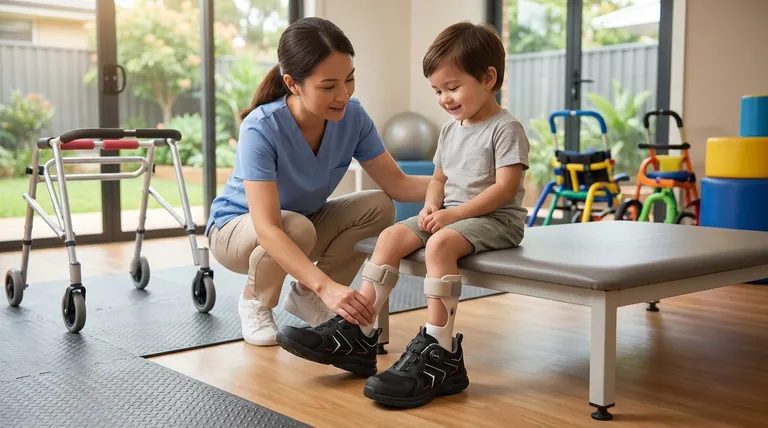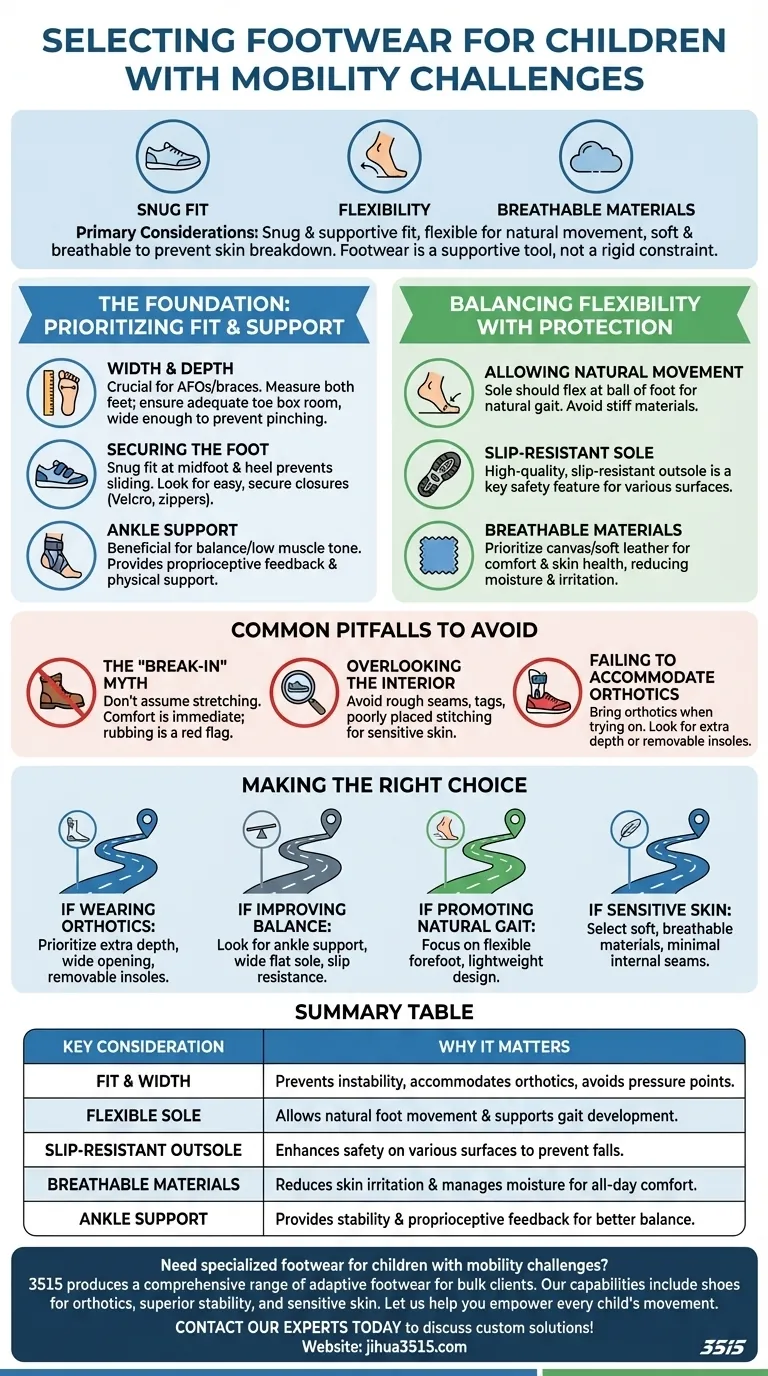When selecting footwear for a child with mobility challenges, the primary considerations are a snug and supportive fit, flexibility that allows for natural foot movement, and soft, breathable materials that prevent skin breakdown. The shoe must function as a supportive tool, not a rigid constraint.
The core objective is to find footwear that acts as an integrated support system for your child's specific needs. This means moving beyond a simple size check to assess how the shoe enhances stability, accommodates orthotics, and promotes a safe, confident gait.

The Foundation: Prioritizing Fit and Support
A proper fit is the non-negotiable starting point. For a child with mobility challenges, an ill-fitting shoe can not only cause discomfort but can actively undermine their stability and create safety risks.
Beyond Length: The Importance of Width and Depth
Most standard shoe sizes focus only on length. However, width and depth are often more critical, especially if the child wears braces like Ankle-Foot Orthotics (AFOs) or has unique foot shapes.
Always measure both of the child's feet, as size discrepancies are common. Ensure there is adequate room in the toe box and that the shoe is wide enough to prevent pinching or pressure points.
Securing the Foot for Stability
A snug fit around the midfoot and heel is essential to prevent the foot from sliding inside the shoe, which can lead to instability and blisters.
Look for closure systems like Velcro straps or zippers that are easy for caregivers to manage but also allow for a secure, adjustable fit throughout the day.
The Role of Ankle Support
While not necessary for every child, shoes that extend over the ankle can provide valuable proprioceptive feedback and physical support. This can be particularly beneficial for children who struggle with balance or have low muscle tone.
Balancing Flexibility with Protection
The ideal shoe offers protection without restricting the foot's natural mechanics. A shoe that is too rigid can hinder gait development and feel unnatural.
Allowing for Natural Movement
The sole of the shoe should be flexible, especially at the ball of the foot. This allows the foot to bend and roll through a step as it naturally would, which is critical for developing an efficient gait pattern.
Avoid heavy, stiff materials that can weigh a child down or force their foot into an unnatural position.
The Critical Nature of the Sole
The outsole is the shoe's point of contact with the world. For a child with mobility challenges, a high-quality, slip-resistant sole is a key safety feature.
The sole should provide good traction on various surfaces, from slick school hallways to uneven playgrounds, to help prevent falls.
Choosing the Right Materials
The materials used in the shoe's upper have a direct impact on comfort and skin health. Prioritize breathable fabrics like canvas or soft leathers.
This helps manage moisture and reduce the risk of skin irritation or breakdown, which is especially important for children who wear their shoes for extended periods.
Common Pitfalls to Avoid
Choosing the right shoe also means knowing what to avoid. Certain common assumptions about footwear do not apply and can lead to poor outcomes.
The "Break-In" Myth
Do not buy a shoe assuming it will "break in" or stretch over time. Adaptive footwear must be comfortable and fit correctly from the very first wear. Any areas of rubbing or excessive pressure are red flags that will likely worsen, not improve.
Overlooking the Interior
Pay close attention to the inside of the shoe. Rough seams, tags, or poorly placed stitching can cause significant irritation for children with heightened sensory sensitivities or fragile skin. The interior should be as smooth as possible.
Failing to Accommodate Orthotics
If your child wears any kind of orthotic or brace, it is crucial to bring it with you when trying on shoes. Look specifically for shoes designed with extra depth or removable insoles to create the necessary space for the device to fit comfortably without cramping the foot.
Making the Right Choice for Your Child
Your final selection should be guided by your child's primary mobility goal.
- If your child wears orthotics (like AFOs): Prioritize shoes with extra depth, a wide opening for easy entry, and removable insoles to ensure a proper fit without pressure points.
- If the primary goal is improving balance and stability: Look for shoes with good ankle support, a flat and wide sole for a solid base, and excellent slip resistance.
- If promoting a natural gait is the main concern: Focus on footwear with a highly flexible forefoot and a lightweight design that doesn't hinder or alter movement.
- If your child has sensitive skin or sensory issues: Select shoes made from soft, breathable materials with minimal internal seams to prevent irritation and ensure comfort.
Ultimately, the right shoe is one that empowers your child to move with confidence, comfort, and safety.
Summary Table:
| Key Consideration | Why It Matters |
|---|---|
| Fit & Width | Prevents instability, accommodates orthotics, and avoids pressure points. |
| Flexible Sole | Allows natural foot movement and supports gait development. |
| Slip-Resistant Outsole | Enhances safety on various surfaces to prevent falls. |
| Breathable Materials | Reduces skin irritation and manages moisture for all-day comfort. |
| Ankle Support | Provides stability and proprioceptive feedback for better balance. |
Need specialized footwear for a child with mobility challenges? As a large-scale manufacturer, 3515 produces a comprehensive range of adaptive footwear for distributors, brand owners, and bulk clients. Our production capabilities include shoes designed for orthotics, superior stability, and sensitive skin—ensuring a perfect blend of support, safety, and comfort. Let us help you empower every child's movement. Contact our experts today to discuss custom solutions!
Visual Guide

Related Products
- Athletic Safety Shoes with Dial Closure & Steel Toe for Wholesale & Custom Manufacturing
- Wholesale Classic Leather Lace-Up Ankle Boots for Brand Manufacturing
- Wholesale Customizable Suede Safety Boots - Puncture-Proof with Velcro Closure
- Customizable Slip-On Safety Shoes Direct from the Factory for Wholesale
- Wholesale Leather Derby Shoes Manufacturer | Customizable Business & Dress Footwear
People Also Ask
- What are the key differences between men's and women's work boots? Ensure Safety & Comfort with the Right Fit
- What types of toe protection are available in safety Wellington boots? Steel vs. Composite Toe Caps
- How do safety shoes contribute to cost savings for companies? A Strategic Investment in Risk and Cost Management
- What safety features should be considered when choosing Wellington work boots? A Guide to Essential PPE
- Why is the last important in work boot design? It's the Anatomical Blueprint for Comfort & Safety



















